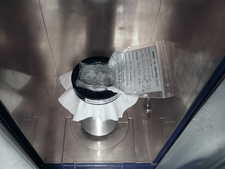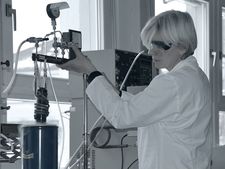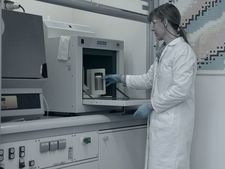-
Topics
subnavigation
Topics
Electromagnetic fields
- What are electromagnetic fields?
- Static and low-frequency fields
- Radiation protection relating to the expansion of the national grid
- High-frequency fields
- Radiation protection in mobile communication
Optical radiation
Ionising radiation
- What is ionising radiation?
- Radioactivity in the environment
- Applications in medicine
- Applications in daily life and in technology
- Effects
- What are the effects of radiation?
- Effects of selected radioactive materials
- Consequences of a radiation accident
- Cancer and leukaemia
- Genetic radiation effects
- Individual radiosensitivity
- Epidemiology of radiation-induced diseases
- Ionising radiation: positive effects?
- Risk estimation and assessment
- Radiation protection
- Nuclear accident management
- Service offers
-
The BfS
subnavigation
The BfS
- About us
- Science and research
- Laws and regulations
- BfS Topics in the Bundestag
- Links
Trace analysis at the BfS
- Using highly sensitive physical measuring systems the BfS is able to detect minute traces of airborne radioactive substances.
- Using the measurements a clear distinction is possible between radioactive traces of natural or artificial origin.
- These measurements are referred to as trace analyses and are used – among others – for the verification of the worldwide ban on nuclear weapons tests.
Tasks and objectives of the trace analysis performed at the BfS are to
- detect minute quantities of natural and artificial airborne radioactivity as well as
- investigate its origin, distribution and dispersion in the environment and
- monitor short and long-term changes at the lowest level of activity.
Legal foundations
Legal foundations for investigations within the scope of trace analysis are
- the Precautionary Radiation Protection Act (StrVG) including measurement programmes given in the General Administrative Regulation on the Integrated Measurement and Information System for the monitoring of environmental radioactivity (AVV-IMIS),
- the European Atomic Energy Community (EURATOM) Treaty,
- the Comprehensive Nuclear-Test-Ban Treaty (CTBT) and
- the Radiation Protection Act (StrlSchG), which entered into force in July 2017 and will replace StrVG and StrlSchV after a transitional period.
The measurement results are summarized by the Coordinating Office for Trace Analysis at the BfS and are reported to the Federal Ministry for the Environment, Nature Conservation and Nuclear Safety (BMU), to the International Atomic Energy Agency (IAEA) as well as to the European Union (EU).
Results are also made available through an electronic system for emergency preparedness (ELAN) to report on the situation in the event of an incident (for example in case of an accident at a nuclear power plant).

![]() Trace analysis air-borne particle collector on the roof of the BfS branch office in Freiburg
Trace analysis air-borne particle collector on the roof of the BfS branch office in Freiburg
Air samples
At the monitoring station Schauinsland and in Freiburg samples of airborne dust and noble gases are collected and then prepared and analysed in the trace analysis laboratories in Freiburg..
The air dust and noble gas samples are collected continuously - generally for a week. If necessary (eg after the accident in Fukushima), precipitation samples are also taken and examined for radionuclides. In addition, noble gas samples from all over the world are analyzed in the noble gas laboratory in Freiburg..
Laboratories
Gamma spectrometry laboratory
- Traces of radioactive substances in airborne dust are detected using gamma spectrometry.
- The required samples are taken using high-volume air samplers, the sampling period is usually one week.
Gamma spectrometry laboratory
The measurements are aimed at determining activities and activity concentrations of various gamma-emitting radionuclides collected from the air using high volume filters.
In order to detect traces of radioactivity, the dust samples are analysed in the gamma spectrometry laboratory of the Freiburg office. These samples are taken
- at the monitoring station on Mount Schauinsland and
- on the roof of the Freiburg office.
Air is drawn through large-surface aerosol filters at an airflow of 700 to 900 cubic meters per hour. The dust particles with the adhering radionuclides deposit on these filters.
Method

![]() Exposed aerosol filter after sampling
Exposed aerosol filter after sampling
The filters are pressed into tablets at the end of each sampling period (usually one week). In order to detect traces of radionuclides, the tablets are measured for several days using highly sensitive high-purity germanium detectors. Lead shielding is used to reduce the influence from background radiation, which is present naturally everywhere and can interfere with the measurement.
Typical limits of detection for the activity concentration of caesium-137 are at around 0.1 micro Becquerel per cubic metre of air.
Not all radionuclides can be identified by their gamma-ray emissions. Radionuclides such as strontium-90 or plutonium have to be radiochemically separated and processed before measurement. This is routinely performed on a monthly basis in the radiochemistry laboratory of the Freiburg office.

![]() Filters pressed into tablet shape
Filters pressed into tablet shape
Monitoring for traces of radioactivity in airborne dust is part of the measurement programmes given in the General Administrative Regulation on the Integrated Measurement and Information System for the monitoring of environmental radioactivity (AVV-IMIS) and of the EURATOM treaty.
Measurements beyond the scope of accreditation
Gaseous iodine
Gaseous iodine in the air cannot be removed by filters. In order to detect gaseous iodine, it is adsorbed on the surface of a solid (activated carbon for example). The sample produced in this process is analysed using gamma spectrometry.
Precipitation samples
If required (after Fukushima for example), precipitation samples are also taken at the monitoring station on Mount Schauinsland and at the Freiburg office, and are analysed for radionuclides. These samples contain radionuclides that have been washed out from the air by precipitation.
Noble gas laboratory
The radioactive isotopes of the noble gases xenon (for example xenon-133) and krypton (krypton-85) play an important role
- in detecting clandestine nuclear activities such as underground nuclear weapons testing and
- as an indicator of reprocessing of nuclear fuels, which is part of the production process of plutonium for nuclear weapons.
- The BfS laboratory supports the Comprehensive Nuclear-Test-Ban Treaty Organization (CTBTO) as a "support laboratory" in setting up a quality assurance programme for the noble gas measuring network of the CTBTO.
Noble Gas Laboratory
The BfS takes weekly air samples
- in Freiburg,
- on Mt. Schauinsland and
- at Bremgarten opposite the French nuclear power plant Fessenheim.
At currently eight other sampling stations around the world, samples are collected in cooperation with other institutions and analysed at the BfS noble gas laboratory. For this purpose, the samples are processed on-site and sent to the noble gas laboratory in pressurized cans or gas containers.
Method

![]() A noble gas sample is worked up for the activity measurement.
A noble gas sample is worked up for the activity measurement.
In the noble gas laboratory, the air sample is processed using gas chromatography; this means that the gas mixture is separated into its individual chemical components.
The activities of the krypton and xenon fractions are then determined by measuring their beta radiation using proportional counters.
Finally, the gas volumes of the analysed krypton or xenon fractions are determined chromatographically.
Limit of detection
Typical activity detection limits of the measurement systems are about 0.03 becquerel for krypton-85 and about 0.01 becquerel for xenon-133.
Noble gas laboratory of the BfS supports CTBTO
The BfS laboratory supports the Comprehensive Nuclear-Test-Ban Treaty Organization (CTBTO) as a "support laboratory" in setting up a quality assurance programme for the noble gas measuring network of the CTBTO.
Within this framework, the noble gas laboratory operates a nuclide-specific xenon measurement system. The accreditation of this system is planned.
Radiochemistry laboratory
Radioanalytical laboratory
Airborne dust samples collected at the monitoring station Schauinsland and in Freiburg are initially analysed in the gamma spectrometry laboratory. Then, in the radioanalytical laboratory, they are processed using radioanalytical methods to separate strontium, uranium and plutonium. .
Method
In order to achieve the lowest possible limit of detection, between four and five weekly samples are combined to a monthly sample and subsequently ashed. The activity concentrations of strontium, uranium and plutonium are determined from the ashes of these samples.
The sample ash is mixed with acid and processed in a specially designed microwave oven. Then, the nuclides to be determined are separated using radioanalytical methods and are deposited on filters or stainless steel planchets
The strontium isotopes are measured using a low-level alpha/beta counter. This system is used for detecting the lowest detectable activities of alpha and beta emitters.
After the electrochemical deposition on stainless steel planchets, the uranium and plutonium isotopes are measured in an alpha spectrometer.

![]() Filter samples are processed in the radiochemistry laboratory
Filter samples are processed in the radiochemistry laboratory
Limits of detection
With the described method, detection limits of
- 1 micro Becquerel per cubic metre of air for strontium-89,
- 0.03 micro Becquerel per cubic metre of air for strontium-90 and
- 0.0005 micro Becquerel per cubic metre of air for the isotopes uranium-234, uranium-235, uranium-238, plutonium-238, plutonium-239 und plutonium-240
are achieved.
State of 2018.02.16


